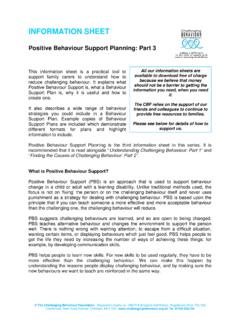Transcription of Dealing with Difficult Customer Behaviour
1 Dealing with Difficult Customer Behaviour Dealing with Difficult Behaviour is something we face in many circumstances at home with children, socially with friends or at sporting events, and at work with co-workers and customers. In the workplace, one of the most Difficult situations for employees is Dealing with customers who are angry. At times the anger escalates to aggressive, abusive or even assaultive Behaviour . A high number of employees have been assaulted during the course of their duties as a result of Difficult situations with customers. This trend is even more common in industries relating to healthcare, social services, banking, and retail trade.
2 The management of Difficult Customer Behaviour has a range of implications for your organisation including: the need to identify and assess outlets where Difficult Customer Behaviour may be considered a risk management issue; the need to support staff in responding to Customer Behaviour appropriately and in line with organisational procedures; the need to support staff in terms of how they react to such incidents, especially in relation to self-care, potential time lost, and worker s compensation issues; and the need to provide skills and supportive mechanisms to managers in order to support their staff. Difficult Customer Behaviour can take many forms, with some of the most common including: arguing with staff confronting staff about their competency requesting impossible time-frames not accepting the limitations and procedures in place making culturally specific and inappropriate comments ifficult Behaviour or Workplace Violence?
3 In many cases, the Behaviour of customers can be seen as a source of external workplace violence and therefore, according to OHS legislation, needs to be minimised or eliminated. The most frequently reported types of Behaviour that can, depending on the situation, constitute workplace violence include: verbal abuse, such as offensive remarks, swearing or name calling; actively hostile Behaviour , including shouting, shaking fists, threatening gestures; and physical abuse, such that may result in injury. In many of our work environments, customers also display a range of behaviours that may be considered challenging, yet the impact of these on staff may not be as serious.
4 It is the challenge of local managers and HR / risk management teams to identify which behaviours constitute a threat to staff and therefore need addressing, while some behaviours may be dealt with by following a consistent plan of action. In understanding the Difficult behaviours we see in customers, it is helpful to understand the most common motivations for engaging in aggressive behaviours : 1. EXPRESSIVE: the majority of people who become aggressive verbally do so as a product of extreme irritation, which may be related to issues such as dissatisfaction with a service or the organisation at large 2. LEARNED: for many people, there is an experience over time that aggressive or angry Behaviour serves a useful purpose and can lead to improved or more efficient service provision 3.
5 RANDOM: for many people, Behaviour escalates more quickly due to psychological or psychiatric reasons. While serious mental illness is NOT correlated with an increase in aggression per se, many individuals experiencing conditions that involve organic brain dysfunction display impulsive or aggressive Behaviour . Drug and alcohol use is also commonly associated with aggressive Behaviour . Managing Difficult Behaviour Understanding the possible reason for the Behaviour can assist staff in their response to it. Individuals that display aggression randomly are the most Difficult to manage since the Behaviour is less predictable, can escalate rapidly, and can be less responsive to attempts to calm the person down.
6 To manage such situations, the organization needs a planned and consistent approach. However, with regard customers who are displaying aggression for expressive or learnt reasons, the response of staff can be efficient in terms of responding to Customer needs, modelling appropriate Behaviour , and providing a positive experience of the organisation. In order to respond well to Difficult Customer situations, employees need to be skilled in a range of areas. A. Assessment This relates to their ability to recognise in themselves that their emotional response to the situation is changing, as well as recognising that the situation may be escalating in terms of the Customer s Behaviour .
7 B. Monitoring Staff members need to be able to monitor both their emotional response, and any mental processes that they experience during the interaction with the Customer . For example, staff need to be able to work with customers and not jump to conclusions about the Customer , make too many generalisations about the Customer or the outcome, or to take the situation too personally. C. Active Listening, Questioning and Clarification These are important skills for staff to learn in order to identify what the Customer is seeking and to ensure that s/he has understood the entire situation. D. Defusing skills The ability to defuse a situation may involve skills such as appropriate questioning techniques, focusing on the problem at hand, using humour where appropriate, and using delay strategies to assist the situation.
8 E. Negotiation and Limit Setting In some Customer situations, it may be appropriate and possible to negotiate an outcome that is agreeable to both parties. with others, for example, in healthcare settings, it may be necessary to set limits with customers in order to clear up misunderstandings, and stay focused on the situation rather than surrounding problems or difficulties. Tips for Managers Ensure that each workplace is assessed to identify common sources of Difficult Behaviour Discuss with staff and design procedures for Dealing with Difficult client Behaviour . Use the managerAssist service to discuss appropriate solutions Educate new staff about likely Customer Behaviour and the procedures to manage this Ensure there is a clear escalation procedure in place Use incidents to assist in re-designing procedures or to address new risk issues Treat each incident individually in terms of assessing staff support needs Ensure staff have access to support mechanisms such as EAP counselling, trauma services or the managerAssist program Ensure staff are encouraged to learn and practice self-care techniques.
9 How Difficult Customer Behaviour is managed has a range of implications for your organisation both from a business perspective and in regard to the management and support of staff. While staff members can be trained to handle Difficult Behaviour more successfully, they also require strong managerial support and the opportunity to develop appropriate strategies to ensure their own well-being.







